class: right, middle, my-title, title-slide # State of the Ecosystem: ## New England 2020 ### Sean Lucey, Sarah Gaichas, Kim Bastille, <br /> Geret DePiper, Kim Hyde, and Scott Large <br /> Northeast Fisheries Science Center --- class: top, left ## State of the Ecosystem (SOE) Reporting: Context for busy people 1. Clear linkage of ecosystem indicators with management objectives 1. Synthesis across indicators for big picture 1. Objectives related to human-well being placed first in report 1. Short (< 30 pages), non-technical (but rigorous) text 1. Emphasis on reproducibility .center[ 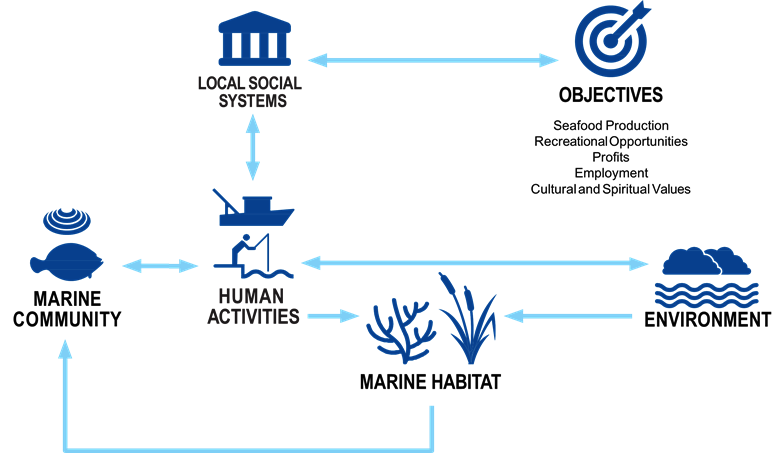 ] ??? In 2016, we began taking steps to address these common critiques of the ESR model --- ## State of the Ecosystem 2020: Response Memo Our response to the need for more formal response to comments: * 30 comments or requests from 2019 * One addressed by having the response memo * 21 addressed within the SOE at SSC/Council request * New summary section with synthetic overview addresses 3 requests * 5 new indicators added * 3 existing indicators modified * 5 editorial updates * 5 partially addressed requests * 8 not currently addressed within SOE * 2 have information summaries in the response memo * 2 may be addressed by student projects * 1 needs feedback on how to deal with known data issue * 1 seeking data * 1 relevant to 2019 visualization that was replaced in 2020 * 1 beyond capacity to address at present SSC/Council feedback requested on the approach and all details, memo has specific questions --- ## State of the Ecosystem 2020: Structure .pull-left[ ### Report Structure 1. Summary 2 pager 1. Human dimensions 1. Protected species 1. Fish and invertebrates (managed and otherwise) 1. Habitat quality and ecosystem productivity ] .pull-right[ *Established ecosystem-scale objectives from Legislature* <table class="risktable table" style="font-size: 14px; margin-left: auto; margin-right: auto;"> <thead> <tr> <th style="text-align:left;font-weight: bold;"> Objective Categories </th> <th style="text-align:left;font-weight: bold;"> Indicators reported here </th> </tr> </thead> <tbody> <tr> <td style="text-align:left;"> Seafood Production </td> <td style="text-align:left;"> Landings by feeding group </td> </tr> <tr> <td style="text-align:left;"> Profits </td> <td style="text-align:left;"> Revenue decomposed to price and volume </td> </tr> <tr> <td style="text-align:left;"> Recreation </td> <td style="text-align:left;"> Days fished; recreational catch </td> </tr> <tr> <td style="text-align:left;"> Stability </td> <td style="text-align:left;"> Diversity indices (fishery and species) </td> </tr> <tr> <td style="text-align:left;"> Social & Cultural </td> <td style="text-align:left;"> Commercial engagement trends </td> </tr> <tr> <td style="text-align:left;"> Biomass </td> <td style="text-align:left;"> Biomass or abundance by feeding group from surveys </td> </tr> <tr> <td style="text-align:left;"> Productivity </td> <td style="text-align:left;"> Condition and recruitment of managed species, Primary productivity </td> </tr> <tr> <td style="text-align:left;"> Trophic structure </td> <td style="text-align:left;"> Relative biomass of feeding groups, Zooplankton </td> </tr> <tr> <td style="text-align:left;"> Habitat </td> <td style="text-align:left;"> Estuarine and offshore habitat conditions </td> </tr> </tbody> </table> ] --- ## New 2 page summary with visualizations .pull-left[ 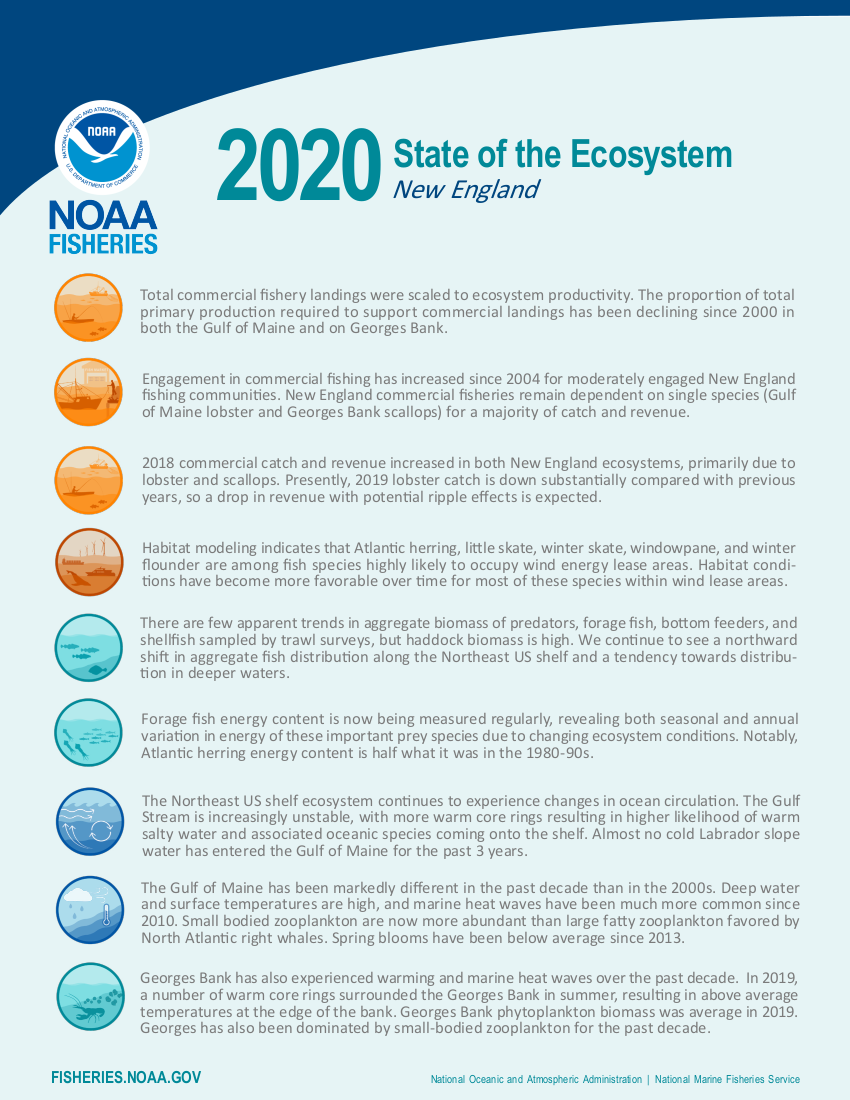 ] .pull-right[ 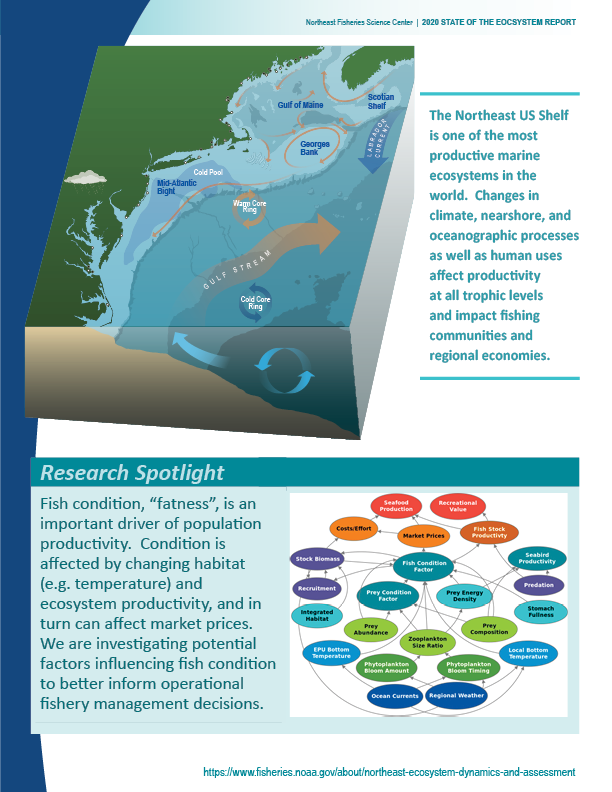 ] --- ## Research: linking report indicators for management use .pull-left[ 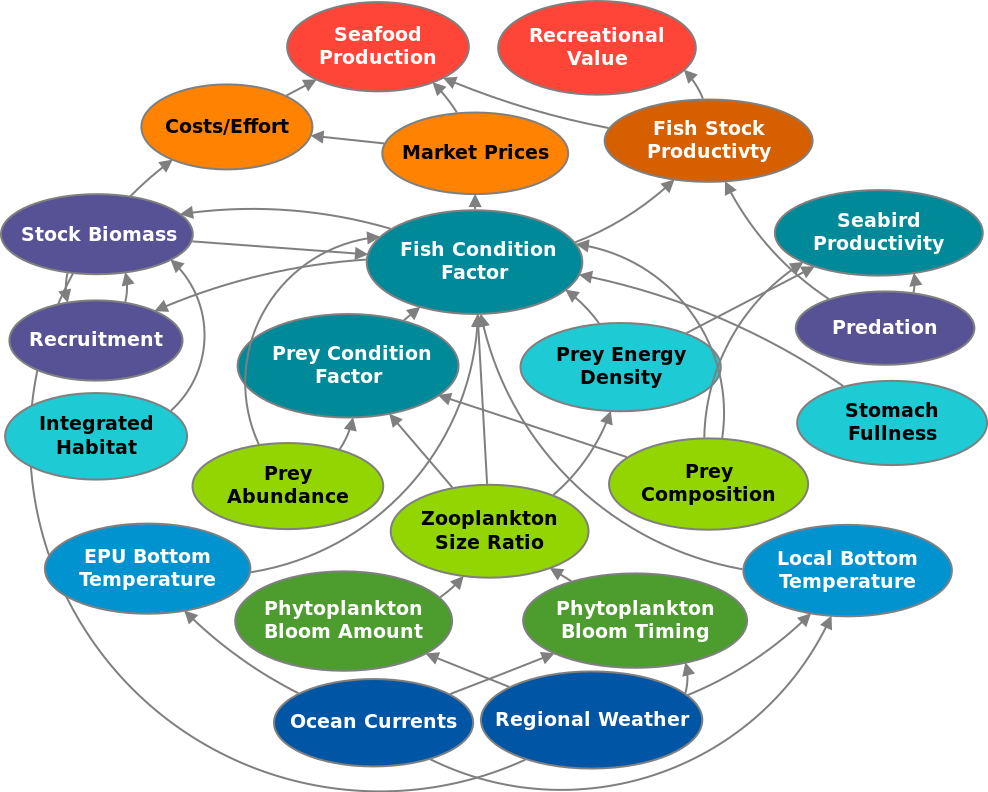 ] .pull-right[ 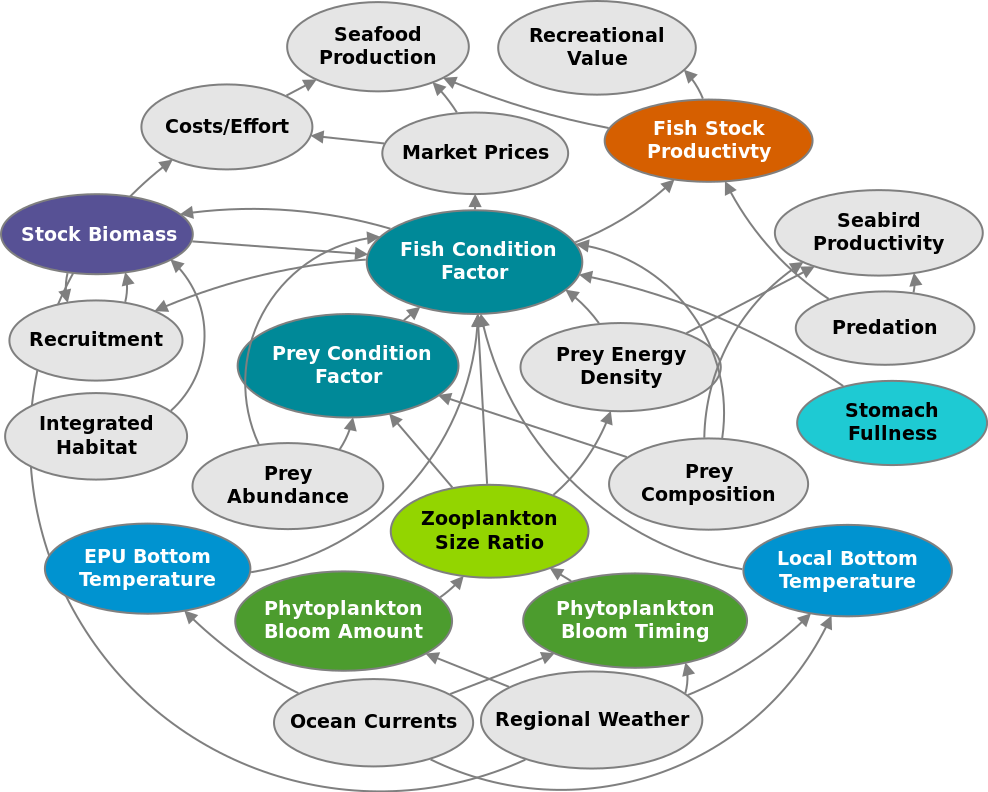 ] Conceptual model links indicators in the report with management objectives. A subset of objectives are currently under investigation. We plan to extend this work in 2020. --- ## Document orientation .pull-left[ Spatial scale 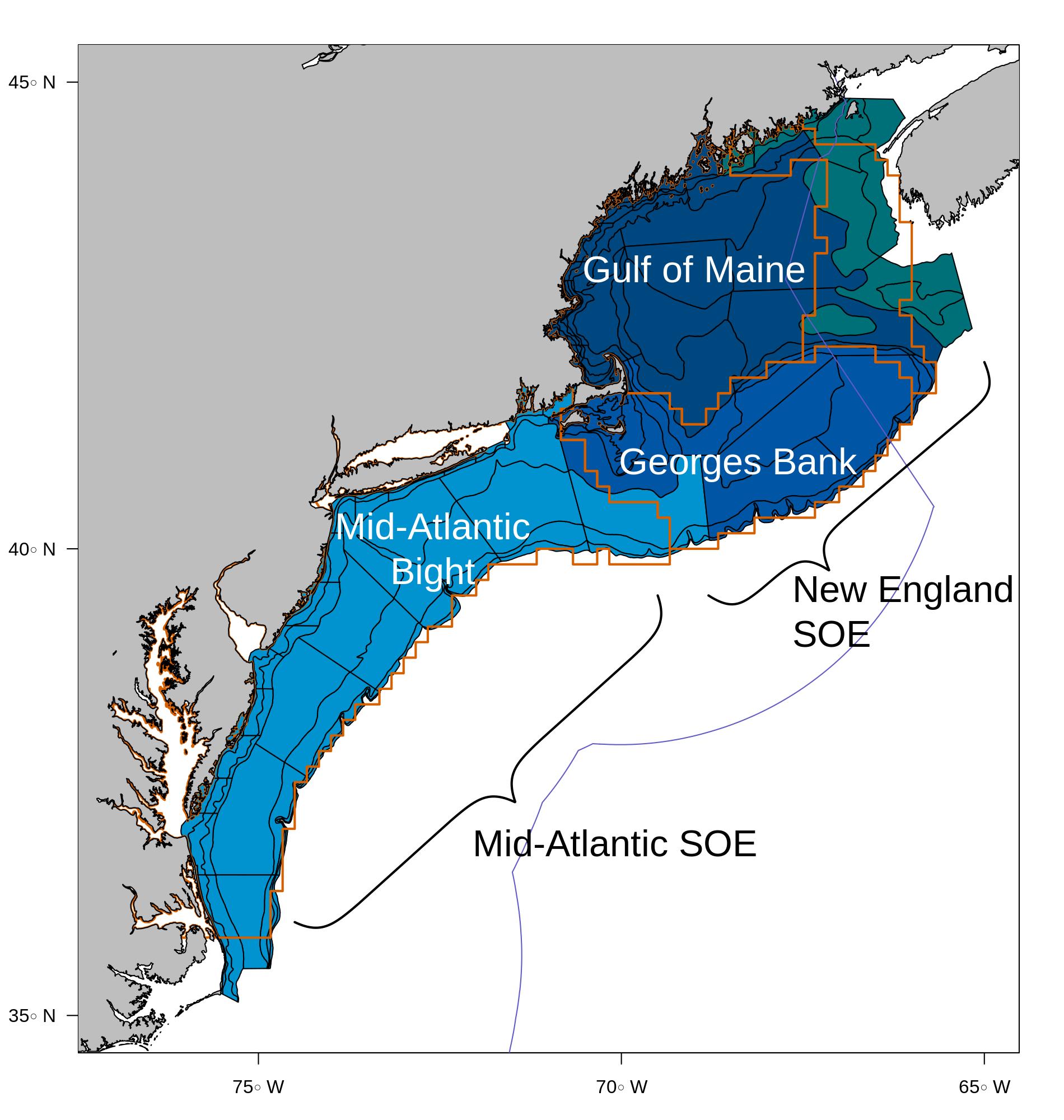 .contrib[ This year, we mapped trawl survey strata to Ecological Production Units (EPUs) [More information on EPUs](https://noaa-edab.github.io/tech-doc/epu.html) [More information on survey data](https://noaa-edab.github.io/tech-doc/survdat.html) ] ] .pull-right[ Key to figures 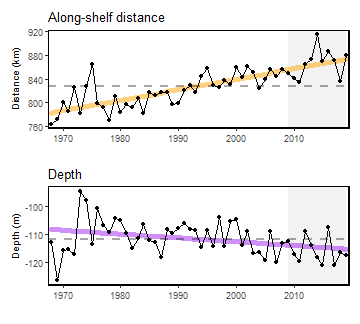 .contrib[ Trends assessed only for 30+ years: [more information](https://noaa-edab.github.io/tech-doc/trend-analysis.html) <p style="color:#FF8C00;">Orange line = significant increase</p> <p style="color:#9932CC;">Purple line = significant decrease</p> No color line = not significant or too short <p style="background-color:#D3D3D3;">Grey background = last 10 years</p> ] ] --- ## Commercial fisheries and ecosystem productivity *Fraction of primary production used by fisheries* .pull-left[ 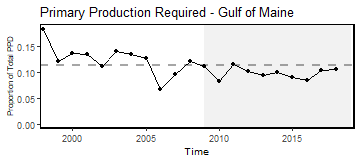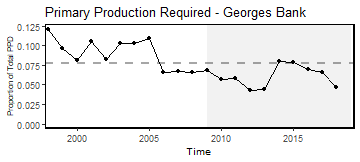 * Declining since 2000 * Landings have remained steady with a slight increase in primary production * Many assumptions to explore ] .pull-right[ ### Georges Bank Species Composition 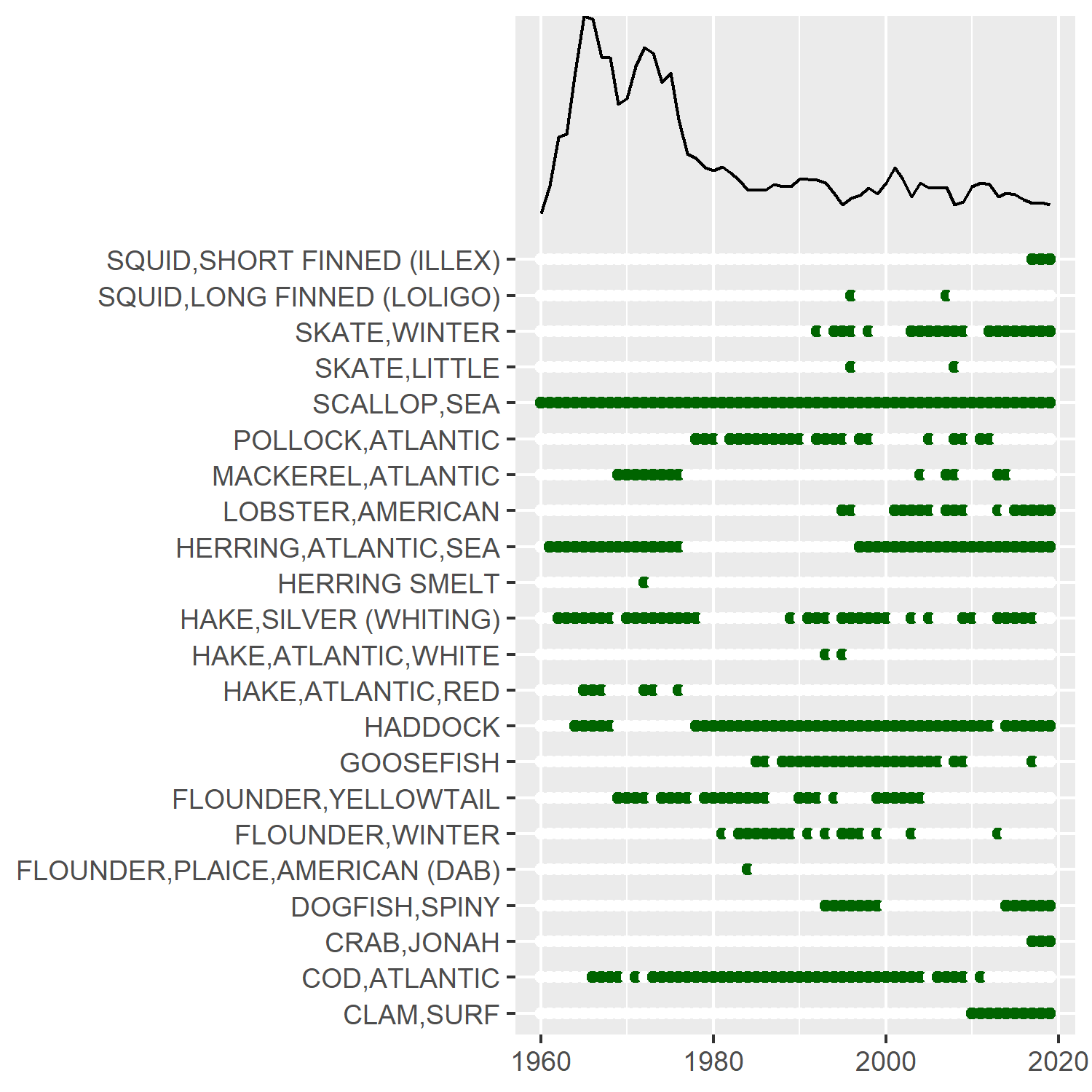 ] --- ## Commercial fisheries: Engagement * Moderate to highly engaged New England communities have increased since 2004 * Engagement scores for medium-highly engaged communities increasing * Linked to landings/revenue 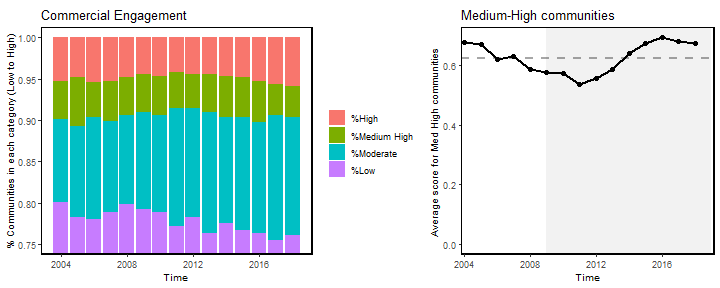 --- ## Commercial fisheries: Revenue * Total Revenue in both regions is up * Largely dependent on single species * Fluctuations on Georges Bank associated with rotational management (Scallops) .pull-left[ **Georges Bank** 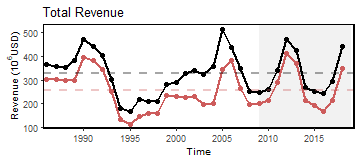 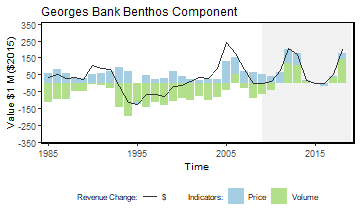 ] .pull-right[ **Gulf of Maine** 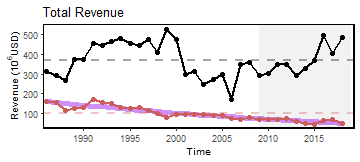 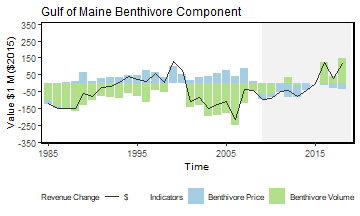 ] --- ## Commercial fisheries: Landings (Georges Bank) .pull-left[ * No long term trends for NEFMC-managed species * Fluctuations, like revenue, associated with rotational management * Planktivore landings (mainly Atlantic herring) returned to the long term average 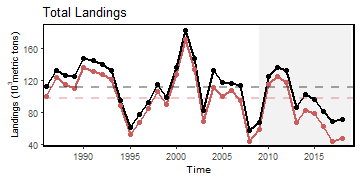 ] .pull-right[ 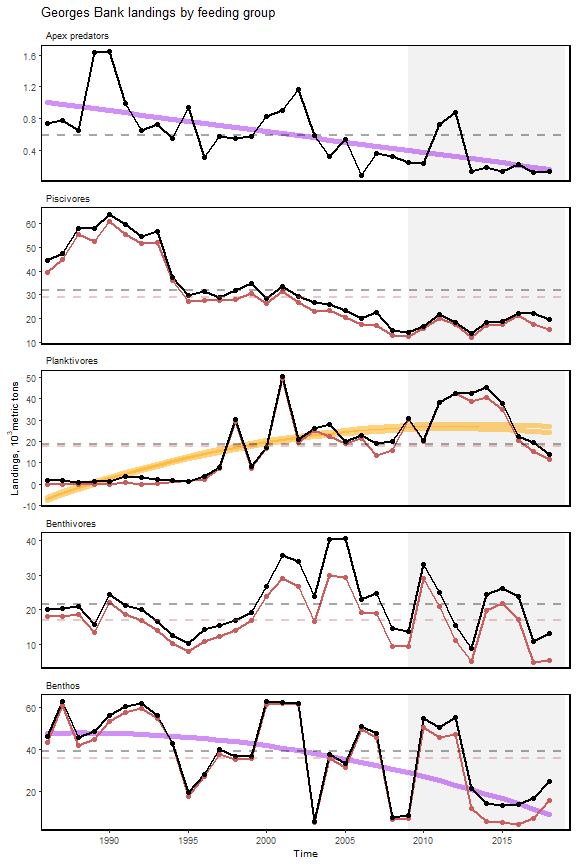 ] --- ## Commercial fisheries: Landings (Gulf of Maine) .pull-left[ * Significant decrease in NEFMC-managed commercial seafood production (non-bait landings) * Several long-term negative trends * Non-NEFMC managed benthivores increasing * Drop in lobster landings in 2019 (not-included) likely to have impacts 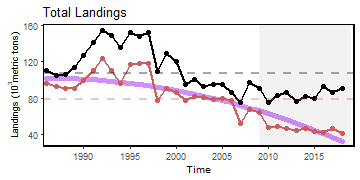 ] .pull-right[ 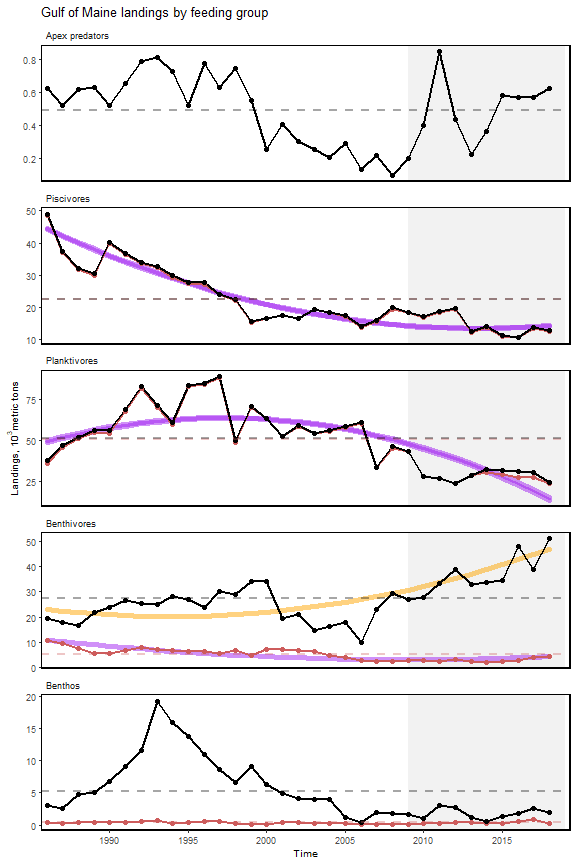 ] --- ## Other ocean uses: wind energy fish habitat overlap <table class="risktable table" style="font-size: 11px; margin-left: auto; margin-right: auto;"> <thead> <tr> <th style="border-bottom:hidden" colspan="1"></th> <th style="border-bottom:hidden; padding-bottom:0; padding-left:3px;padding-right:3px;text-align: center; " colspan="2"><div style="border-bottom: 1px solid #ddd; padding-bottom: 5px; ">Existing - North</div></th> <th style="border-bottom:hidden; padding-bottom:0; padding-left:3px;padding-right:3px;text-align: center; " colspan="2"><div style="border-bottom: 1px solid #ddd; padding-bottom: 5px; ">Proposed - North</div></th> <th style="border-bottom:hidden; padding-bottom:0; padding-left:3px;padding-right:3px;text-align: center; " colspan="2"><div style="border-bottom: 1px solid #ddd; padding-bottom: 5px; ">Existing - Mid</div></th> <th style="border-bottom:hidden; padding-bottom:0; padding-left:3px;padding-right:3px;text-align: center; " colspan="2"><div style="border-bottom: 1px solid #ddd; padding-bottom: 5px; ">Proposed - Mid</div></th> <th style="border-bottom:hidden; padding-bottom:0; padding-left:3px;padding-right:3px;text-align: center; " colspan="2"><div style="border-bottom: 1px solid #ddd; padding-bottom: 5px; ">Existing - South</div></th> </tr> <tr> <th style="text-align:left;font-weight: bold;"> Season </th> <th style="text-align:left;font-weight: bold;"> Species </th> <th style="text-align:left;font-weight: bold;"> Trend </th> <th style="text-align:left;font-weight: bold;"> Species </th> <th style="text-align:left;font-weight: bold;"> Trend </th> <th style="text-align:left;font-weight: bold;"> Species </th> <th style="text-align:left;font-weight: bold;"> Trend </th> <th style="text-align:left;font-weight: bold;"> Species </th> <th style="text-align:left;font-weight: bold;"> Trend </th> <th style="text-align:left;font-weight: bold;"> Species </th> <th style="text-align:left;font-weight: bold;"> Trend </th> </tr> </thead> <tbody> <tr> <td style="text-align:left;"> Spring </td> <td style="text-align:left;"> Little Skate </td> <td style="text-align:left;"> `\(\nearrow\)` </td> <td style="text-align:left;"> Atlantic Herring </td> <td style="text-align:left;"> </td> <td style="text-align:left;"> Little Skate </td> <td style="text-align:left;"> `\(\nearrow\)` </td> <td style="text-align:left;"> Spiny Dogfish </td> <td style="text-align:left;"> `\(\nearrow\)` </td> <td style="text-align:left;"> Spiny Dogfish </td> <td style="text-align:left;"> `\(\nearrow\)` </td> </tr> <tr> <td style="text-align:left;"> Spring </td> <td style="text-align:left;"> Atlantic Herring </td> <td style="text-align:left;"> `\(\searrow\)` </td> <td style="text-align:left;"> Little Skate </td> <td style="text-align:left;"> `\(\nearrow\)` </td> <td style="text-align:left;"> Atlantic Herring </td> <td style="text-align:left;"> `\(\searrow\)` </td> <td style="text-align:left;"> Atlantic Herring </td> <td style="text-align:left;"> `\(\searrow\)` </td> <td style="text-align:left;"> Longfin Squid </td> <td style="text-align:left;"> `\(\nearrow\)` </td> </tr> <tr> <td style="text-align:left;"> Spring </td> <td style="text-align:left;"> Windowpane </td> <td style="text-align:left;"> `\(\nearrow\)` </td> <td style="text-align:left;"> Longhorn Sculpin </td> <td style="text-align:left;"> `\(\nearrow\)` </td> <td style="text-align:left;"> Spiny Dogfish </td> <td style="text-align:left;"> `\(\nearrow\)` </td> <td style="text-align:left;"> Little Skate </td> <td style="text-align:left;"> `\(\nearrow\)` </td> <td style="text-align:left;"> Summer Flounder </td> <td style="text-align:left;"> `\(\nearrow\)` </td> </tr> <tr> <td style="text-align:left;"> Spring </td> <td style="text-align:left;"> Winter Skate </td> <td style="text-align:left;"> `\(\nearrow\)` </td> <td style="text-align:left;"> Windowpane </td> <td style="text-align:left;"> `\(\nearrow\)` </td> <td style="text-align:left;"> Windowpane </td> <td style="text-align:left;"> `\(\nearrow\)` </td> <td style="text-align:left;"> Alewife </td> <td style="text-align:left;"> `\(\searrow\)` </td> <td style="text-align:left;"> Clearnose Skate </td> <td style="text-align:left;"> `\(\nearrow\)` </td> </tr> <tr> <td style="text-align:left;"> Spring </td> <td style="text-align:left;"> Longhorn Sculpin </td> <td style="text-align:left;"> `\(\nearrow\)` </td> <td style="text-align:left;"> Alewife </td> <td style="text-align:left;"> `\(\searrow\)` </td> <td style="text-align:left;"> Winter Skate </td> <td style="text-align:left;"> `\(\nearrow\)` </td> <td style="text-align:left;"> Silver Hake </td> <td style="text-align:left;"> `\(\nearrow\)` </td> <td style="text-align:left;"> Spotted Hake </td> <td style="text-align:left;"> `\(\nearrow\)` </td> </tr> <tr> <td style="text-align:left;"> Fall </td> <td style="text-align:left;"> Butterfish </td> <td style="text-align:left;"> `\(\nearrow\)` </td> <td style="text-align:left;"> Butterfish </td> <td style="text-align:left;"> `\(\nearrow\)` </td> <td style="text-align:left;"> Summer Flounder </td> <td style="text-align:left;"> `\(\nearrow\)` </td> <td style="text-align:left;"> Longhorn Sculpin </td> <td style="text-align:left;"> `\(\nearrow\)` </td> <td style="text-align:left;"> Longfin Squid </td> <td style="text-align:left;"> `\(\searrow\)` </td> </tr> <tr> <td style="text-align:left;"> Fall </td> <td style="text-align:left;"> Longfin Squid </td> <td style="text-align:left;"> `\(\nearrow\)` </td> <td style="text-align:left;"> Fourspot Flounder </td> <td style="text-align:left;"> </td> <td style="text-align:left;"> Longfin Squid </td> <td style="text-align:left;"> `\(\nearrow\)` </td> <td style="text-align:left;"> Little Skate </td> <td style="text-align:left;"> `\(\nearrow\)` </td> <td style="text-align:left;"> Northern Searobin </td> <td style="text-align:left;"> `\(\nearrow\)` </td> </tr> <tr> <td style="text-align:left;"> Fall </td> <td style="text-align:left;"> Summer Flounder </td> <td style="text-align:left;"> `\(\nearrow\)` </td> <td style="text-align:left;"> Longhorn Sculpin </td> <td style="text-align:left;"> `\(\searrow\)` </td> <td style="text-align:left;"> Butterfish </td> <td style="text-align:left;"> `\(\nearrow\)` </td> <td style="text-align:left;"> Butterfish </td> <td style="text-align:left;"> `\(\nearrow\)` </td> <td style="text-align:left;"> Clearnose Skate </td> <td style="text-align:left;"> `\(\nearrow\)` </td> </tr> <tr> <td style="text-align:left;"> Fall </td> <td style="text-align:left;"> Winter Flounder </td> <td style="text-align:left;"> `\(\searrow\)` </td> <td style="text-align:left;"> Summer Flounder </td> <td style="text-align:left;"> `\(\nearrow\)` </td> <td style="text-align:left;"> Smooth Dogfish </td> <td style="text-align:left;"> `\(\nearrow\)` </td> <td style="text-align:left;"> Sea Scallop </td> <td style="text-align:left;"> `\(\nearrow\)` </td> <td style="text-align:left;"> Butterfish </td> <td style="text-align:left;"> `\(\nearrow\)` </td> </tr> <tr> <td style="text-align:left;"> Fall </td> <td style="text-align:left;"> Spiny Dogfish </td> <td style="text-align:left;"> `\(\searrow\)` </td> <td style="text-align:left;"> Spiny Dogfish </td> <td style="text-align:left;"> `\(\searrow\)` </td> <td style="text-align:left;"> Windowpane </td> <td style="text-align:left;"> `\(\nearrow\)` </td> <td style="text-align:left;"> Fourspot Flounder </td> <td style="text-align:left;"> `\(\nearrow\)` </td> <td style="text-align:left;"> Spiny Dogfish/Spotted Hake </td> <td style="text-align:left;"> `\(\nearrow\)` </td> </tr> </tbody> </table> .pull-left[ 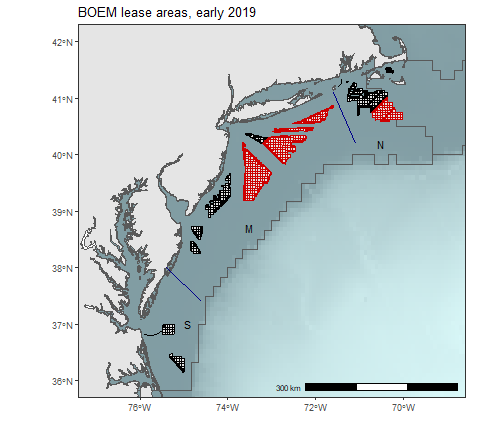 ] .pull-right[ ## Fishery overlap to be added ## What habitat model outputs most useful? ] --- ## Protected species .pull-left[ North Atlantic right whale abundance 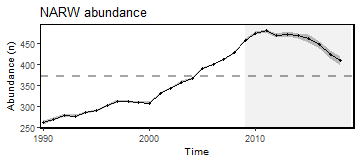 **New indicator** North Atlantic right whale calf births 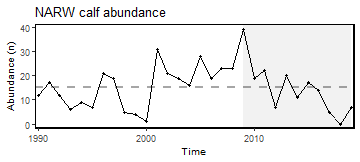 ] .pull-right[ Seal population snapshots + ~75,000 harbor seals, trend analysis in progress + 30,000 - 40,000 grey seals in US; 425,000 in Canada and ↗ Seal diet studies in progress Unusual Mortality Events + [North Atlantic right whales](https://www.fisheries.noaa.gov/national/marine-life-distress/2017-2020-north-atlantic-right-whale-unusual-mortality-event) + [Humpback whales](https://www.fisheries.noaa.gov/national/marine-life-distress/2016-2020-humpback-whale-unusual-mortality-event-along-atlantic-coast) + [Minke whales](https://www.fisheries.noaa.gov/national/marine-life-distress/2017-2020-minke-whale-unusual-mortality-event-along-atlantic-coast) + [Grey, harbor, hooded, and harp seals](https://www.fisheries.noaa.gov/new-england-mid-atlantic/marine-life-distress/2018-2019-pinniped-unusual-mortality-event-along) ] --- ## Fish stock status 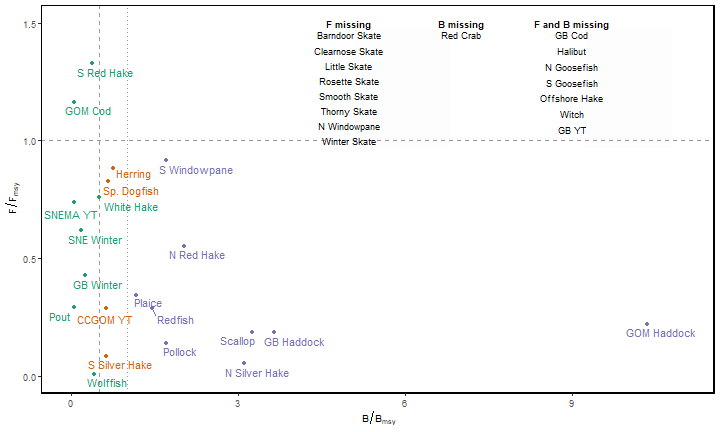 --- ## Aggregate fish distribution and southern species .pull-left[ Overall fish biomass tracking northeast and deeper 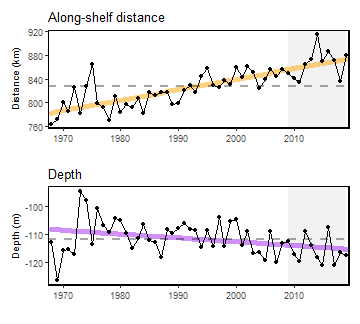 ] .pull-right[ Southern species not increasing in surveys, but further north? 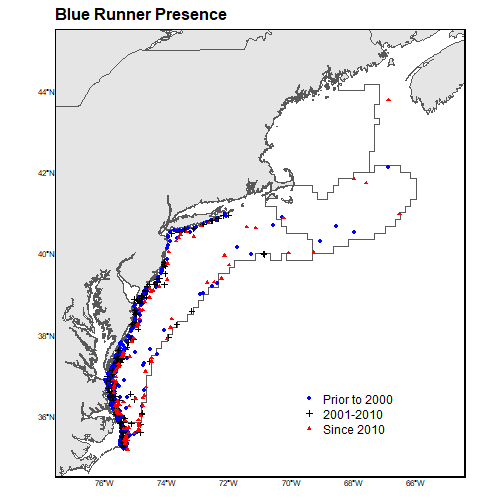 ] --- ## Updated fish feeding groups to look at aggregate biomass <table class="table" style="font-size: 12px; margin-left: auto; margin-right: auto;"> <caption style="font-size: initial !important;">Feeding groups and management bodies.</caption> <thead> <tr> <th style="text-align:left;font-weight: bold;"> Feeding Group </th> <th style="text-align:left;font-weight: bold;"> MAFMC </th> <th style="text-align:left;font-weight: bold;"> Joint </th> <th style="text-align:left;font-weight: bold;"> NEFMC </th> <th style="text-align:left;font-weight: bold;"> State or Other </th> </tr> </thead> <tbody> <tr> <td style="text-align:left;width: 2cm; "> Apex Predator </td> <td style="text-align:left;width: 4cm; "> NA </td> <td style="text-align:left;width: 2cm; "> NA </td> <td style="text-align:left;width: 5cm; "> NA </td> <td style="text-align:left;width: 6cm; "> bluefin tuna, shark uncl, swordfish, yellowfin tuna </td> </tr> <tr> <td style="text-align:left;width: 2cm; "> Piscivore </td> <td style="text-align:left;width: 4cm; "> bluefish, longfin squid, northern shortfin squid, summer flounder </td> <td style="text-align:left;width: 2cm; "> goosefish, spiny dogfish </td> <td style="text-align:left;width: 5cm; "> acadian redfish, atlantic cod, atlantic halibut, clearnose skate, little skate, offshore hake, pollock, red hake, silver hake, smooth skate, thorny skate, white hake, winter skate </td> <td style="text-align:left;width: 6cm; "> fourspot flounder, john dory, sea raven, striped bass, weakfish, windowpane </td> </tr> <tr> <td style="text-align:left;width: 2cm; "> Planktivore </td> <td style="text-align:left;width: 4cm; "> atlantic mackerel, butterfish </td> <td style="text-align:left;width: 2cm; "> NA </td> <td style="text-align:left;width: 5cm; "> atlantic herring </td> <td style="text-align:left;width: 6cm; "> alewife, american shad, blackbelly rosefish, blueback herring, cusk, longhorn sculpin, lumpfish, menhaden, northern sand lance, northern searobin, sculpin uncl </td> </tr> <tr> <td style="text-align:left;width: 2cm; "> Benthivore </td> <td style="text-align:left;width: 4cm; "> black sea bass, scup, tilefish </td> <td style="text-align:left;width: 2cm; "> NA </td> <td style="text-align:left;width: 5cm; "> american plaice, barndoor skate, crab,red deepsea, haddock, ocean pout, rosette skate, winter flounder, witch flounder, yellowtail flounder </td> <td style="text-align:left;width: 6cm; "> american lobster, atlantic wolffish, blue crab, cancer crab uncl, chain dogfish, cunner, jonah crab, lady crab, smooth dogfish, spider crab uncl, squid cuttlefish and octopod uncl, striped searobin, tautog </td> </tr> <tr> <td style="text-align:left;width: 2cm; "> Benthos </td> <td style="text-align:left;width: 4cm; "> atlantic surfclam, ocean quahog </td> <td style="text-align:left;width: 2cm; "> NA </td> <td style="text-align:left;width: 5cm; "> sea scallop </td> <td style="text-align:left;width: 6cm; "> blue mussel, channeled whelk, sea cucumber, sea urchin and sand dollar uncl, sea urchins, snails(conchs) </td> </tr> </tbody> </table> --- ## Aggregate fish biomass (Offshore) .center[ 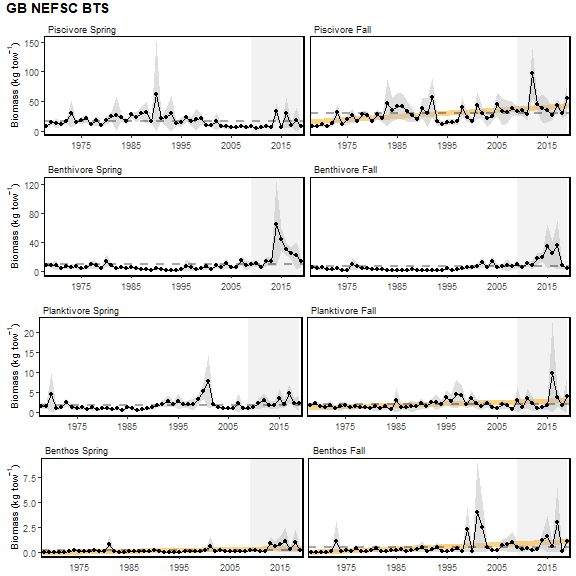 ] --- ## Aggregate fish biomass (Inshore) .center[ 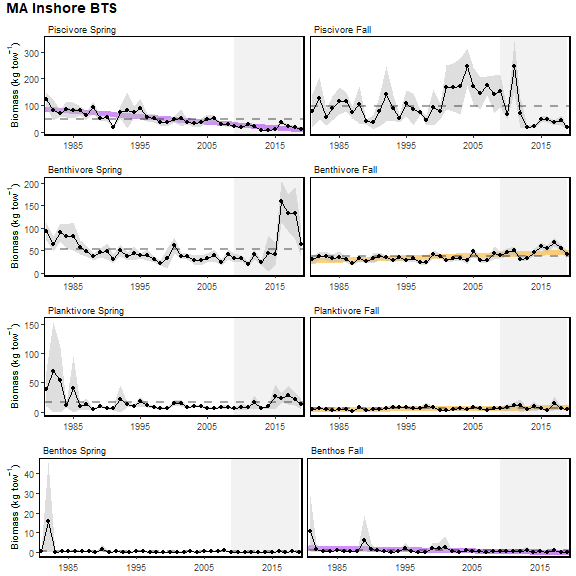 ] --- ## Fish condition Female fish "fatness" from fall surveys .pull-left-30[ **Georges Bank** **Gulf of Maine** ] .pull-right-70[ 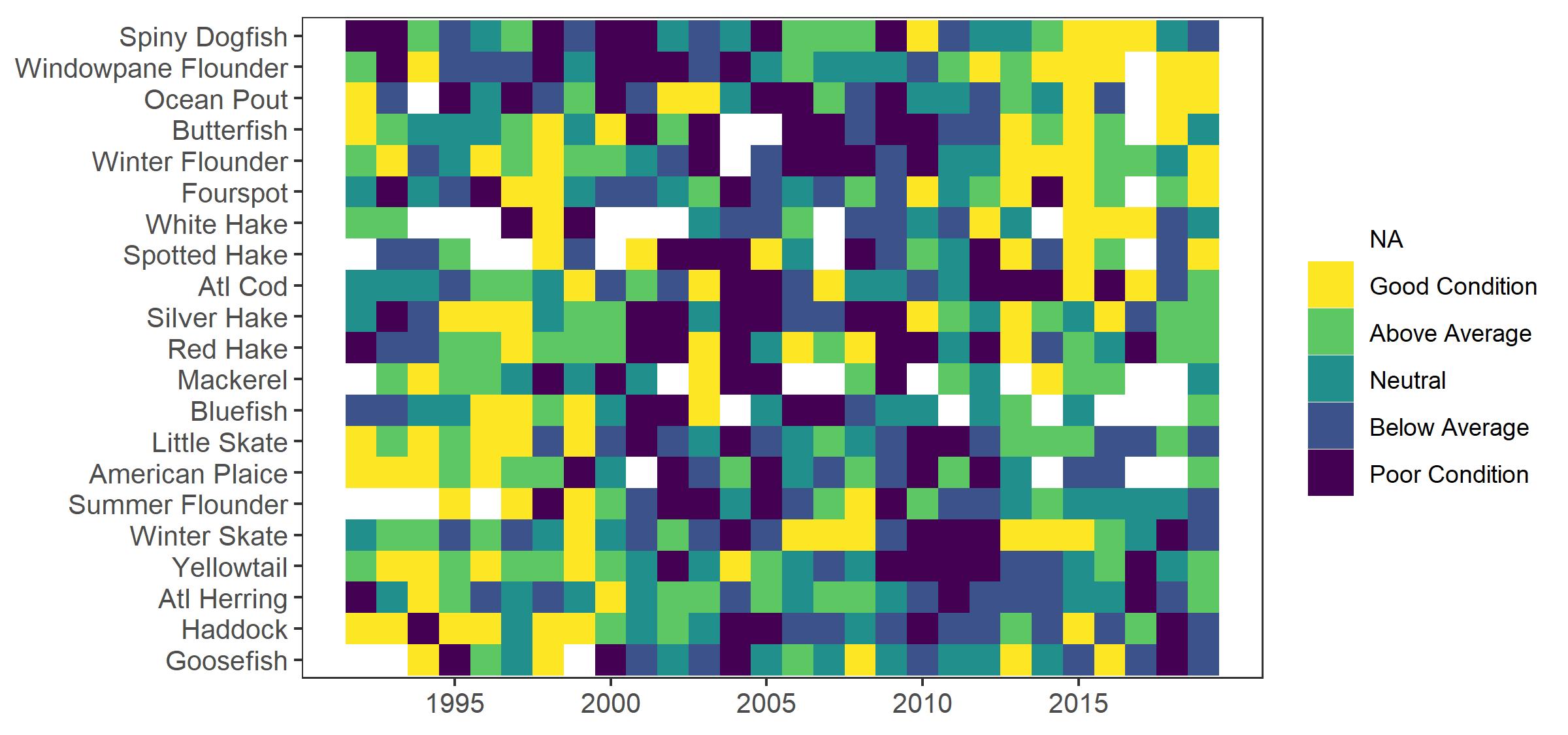  ] --- ## Forage fish energy density (New) * Forage fish energy content varies seasonally and annually * Atlantic herring energy content may be half what it was in the 1980s-90s <table class="table" style="font-size: 11px; margin-left: auto; margin-right: auto;"> <thead> <tr> <th style="border-bottom:hidden" colspan="1"></th> <th style="border-bottom:hidden; padding-bottom:0; padding-left:3px;padding-right:3px;text-align: center; " colspan="2"><div style="border-bottom: 1px solid #ddd; padding-bottom: 5px; ">Spring 2017</div></th> <th style="border-bottom:hidden; padding-bottom:0; padding-left:3px;padding-right:3px;text-align: center; " colspan="2"><div style="border-bottom: 1px solid #ddd; padding-bottom: 5px; ">Fall 2017</div></th> <th style="border-bottom:hidden; padding-bottom:0; padding-left:3px;padding-right:3px;text-align: center; " colspan="2"><div style="border-bottom: 1px solid #ddd; padding-bottom: 5px; ">Spring 2018</div></th> <th style="border-bottom:hidden; padding-bottom:0; padding-left:3px;padding-right:3px;text-align: center; " colspan="2"><div style="border-bottom: 1px solid #ddd; padding-bottom: 5px; ">Fall 2018</div></th> <th style="border-bottom:hidden; padding-bottom:0; padding-left:3px;padding-right:3px;text-align: center; " colspan="2"><div style="border-bottom: 1px solid #ddd; padding-bottom: 5px; ">Total</div></th> <th style="border-bottom:hidden; padding-bottom:0; padding-left:3px;padding-right:3px;text-align: center; " colspan="1"><div style="border-bottom: 1px solid #ddd; padding-bottom: 5px; ">1980s</div></th> <th style="border-bottom:hidden; padding-bottom:0; padding-left:3px;padding-right:3px;text-align: center; " colspan="1"><div style="border-bottom: 1px solid #ddd; padding-bottom: 5px; ">1990s</div></th> </tr> <tr> <th style="text-align:left;font-weight: bold;"> Species </th> <th style="text-align:left;font-weight: bold;"> ED (SD) </th> <th style="text-align:right;font-weight: bold;"> N </th> <th style="text-align:left;font-weight: bold;"> ED (SD) </th> <th style="text-align:right;font-weight: bold;"> N </th> <th style="text-align:left;font-weight: bold;"> ED (SD) </th> <th style="text-align:right;font-weight: bold;"> N </th> <th style="text-align:left;font-weight: bold;"> ED (SD) </th> <th style="text-align:right;font-weight: bold;"> N </th> <th style="text-align:left;font-weight: bold;"> ED (SD) </th> <th style="text-align:right;font-weight: bold;"> N </th> <th style="text-align:right;font-weight: bold;"> ED </th> <th style="text-align:left;font-weight: bold;"> ED (SD) </th> </tr> </thead> <tbody> <tr> <td style="text-align:left;"> Alewife </td> <td style="text-align:left;"> 6.84 (1.62) </td> <td style="text-align:right;"> 128 </td> <td style="text-align:left;"> 8.12 (1.46) </td> <td style="text-align:right;"> 50 </td> <td style="text-align:left;"> 6.45 (1.21) </td> <td style="text-align:right;"> 47 </td> <td style="text-align:left;"> 7.41 (1.6) </td> <td style="text-align:right;"> 42 </td> <td style="text-align:left;"> 7.1 (1.62) </td> <td style="text-align:right;"> 267 </td> <td style="text-align:right;"> 6.4 </td> <td style="text-align:left;"> </td> </tr> <tr> <td style="text-align:left;"> Atl. Herring </td> <td style="text-align:left;"> 5.34 (0.94) </td> <td style="text-align:right;"> 122 </td> <td style="text-align:left;"> 5.77 (1.31) </td> <td style="text-align:right;"> 52 </td> <td style="text-align:left;"> 6.69 (0.85) </td> <td style="text-align:right;"> 51 </td> <td style="text-align:left;"> 5.41 (1.34) </td> <td style="text-align:right;"> 50 </td> <td style="text-align:left;"> 5.69 (1.19) </td> <td style="text-align:right;"> 275 </td> <td style="text-align:right;"> 10.6 </td> <td style="text-align:left;"> 9.4 (1.4) </td> </tr> <tr> <td style="text-align:left;"> Atl. Mackerel </td> <td style="text-align:left;"> </td> <td style="text-align:right;"> NA </td> <td style="text-align:left;"> 7.24 (1.13) </td> <td style="text-align:right;"> 50 </td> <td style="text-align:left;"> 5.33 (0.86) </td> <td style="text-align:right;"> 51 </td> <td style="text-align:left;"> 6.89 (1.07) </td> <td style="text-align:right;"> 50 </td> <td style="text-align:left;"> 6.48 (1.32) </td> <td style="text-align:right;"> 151 </td> <td style="text-align:right;"> 6.0 </td> <td style="text-align:left;"> </td> </tr> <tr> <td style="text-align:left;"> Butterfish </td> <td style="text-align:left;"> 7.13 (1.59) </td> <td style="text-align:right;"> 65 </td> <td style="text-align:left;"> 7.31 (1.45) </td> <td style="text-align:right;"> 89 </td> <td style="text-align:left;"> 4.91 (1.12) </td> <td style="text-align:right;"> 53 </td> <td style="text-align:left;"> 8.1 (2.7) </td> <td style="text-align:right;"> 50 </td> <td style="text-align:left;"> 6.92 (2.04) </td> <td style="text-align:right;"> 257 </td> <td style="text-align:right;"> 6.2 </td> <td style="text-align:left;"> </td> </tr> <tr> <td style="text-align:left;"> Illex </td> <td style="text-align:left;"> 5.54 (0.4) </td> <td style="text-align:right;"> 77 </td> <td style="text-align:left;"> 5.43 (0.51) </td> <td style="text-align:right;"> 52 </td> <td style="text-align:left;"> 5.5 (0.52) </td> <td style="text-align:right;"> 50 </td> <td style="text-align:left;"> 4.76 (0.79) </td> <td style="text-align:right;"> 50 </td> <td style="text-align:left;"> 5.33 (0.63) </td> <td style="text-align:right;"> 229 </td> <td style="text-align:right;"> 7.1 </td> <td style="text-align:left;"> 5.9 (0.56) </td> </tr> <tr> <td style="text-align:left;"> Loligo </td> <td style="text-align:left;"> 5.22 (0.36) </td> <td style="text-align:right;"> 83 </td> <td style="text-align:left;"> 5.24 (0.26) </td> <td style="text-align:right;"> 60 </td> <td style="text-align:left;"> 4.84 (0.63) </td> <td style="text-align:right;"> 52 </td> <td style="text-align:left;"> 4.6 (0.72) </td> <td style="text-align:right;"> 50 </td> <td style="text-align:left;"> 5.02 (0.56) </td> <td style="text-align:right;"> 245 </td> <td style="text-align:right;"> 5.6 </td> <td style="text-align:left;"> </td> </tr> <tr> <td style="text-align:left;"> Sand lance </td> <td style="text-align:left;"> 6.66 (0.54) </td> <td style="text-align:right;"> 18 </td> <td style="text-align:left;"> </td> <td style="text-align:right;"> NA </td> <td style="text-align:left;"> 5.78 (0.34) </td> <td style="text-align:right;"> 60 </td> <td style="text-align:left;"> 7.99 (0.74) </td> <td style="text-align:right;"> 8 </td> <td style="text-align:left;"> 6.17 (0.81) </td> <td style="text-align:right;"> 86 </td> <td style="text-align:right;"> 6.8 </td> <td style="text-align:left;"> 4.4 (0.82) </td> </tr> <tr> <td style="text-align:left;"> Silver hake </td> <td style="text-align:left;"> 4.25 (0.39) </td> <td style="text-align:right;"> 189 </td> <td style="text-align:left;"> 4.42 (0.45) </td> <td style="text-align:right;"> 50 </td> <td style="text-align:left;"> 4.19 (0.39) </td> <td style="text-align:right;"> 50 </td> <td style="text-align:left;"> 4.55 (0.63) </td> <td style="text-align:right;"> 50 </td> <td style="text-align:left;"> 4.31 (0.46) </td> <td style="text-align:right;"> 339 </td> <td style="text-align:right;"> 4.6 </td> <td style="text-align:left;"> </td> </tr> </tbody> </table> --- ## Habitat condition: large ocean current changes .pull-left[ 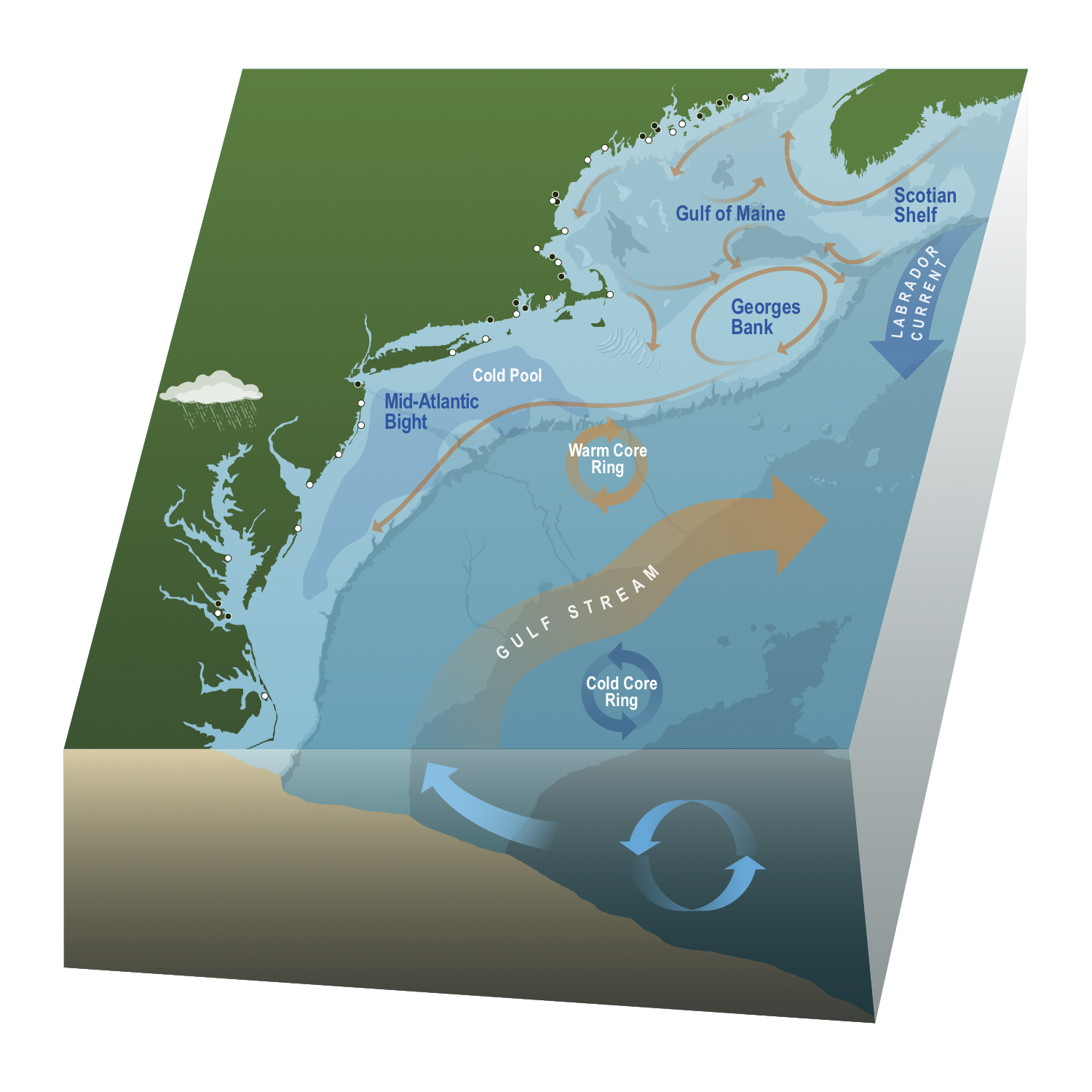 * More northerly Gulf Stream * More Gulf Stream warm core rings * Almost no Labrador slope water entering the Gulf of Maine 2017-2019 ] .pull-right[ 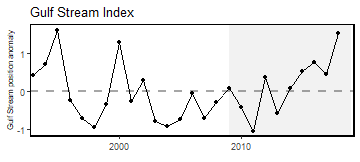 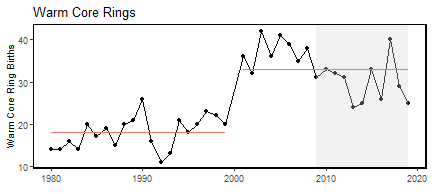 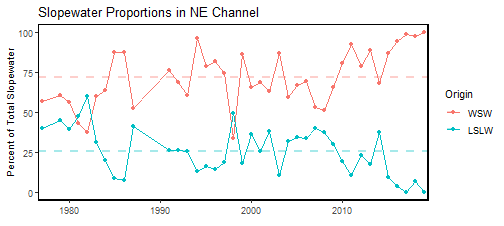 ] --- ## Regional temperatures .pull-left-60[ Seasonal sea surface temperature anomalies 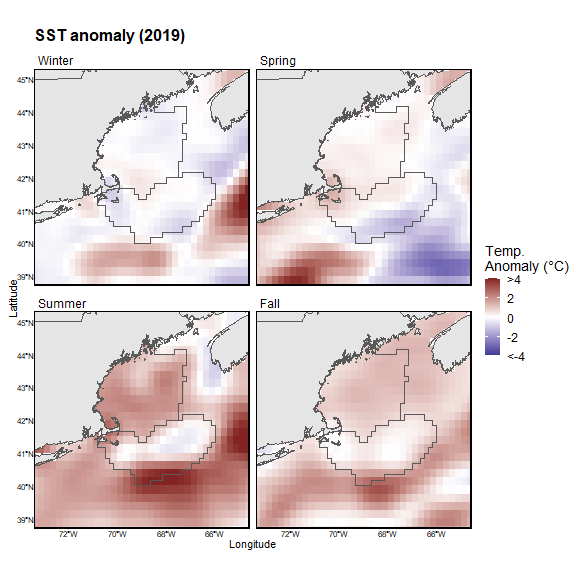 ] .pull-right-40[ Annual bottom temperature anomalies 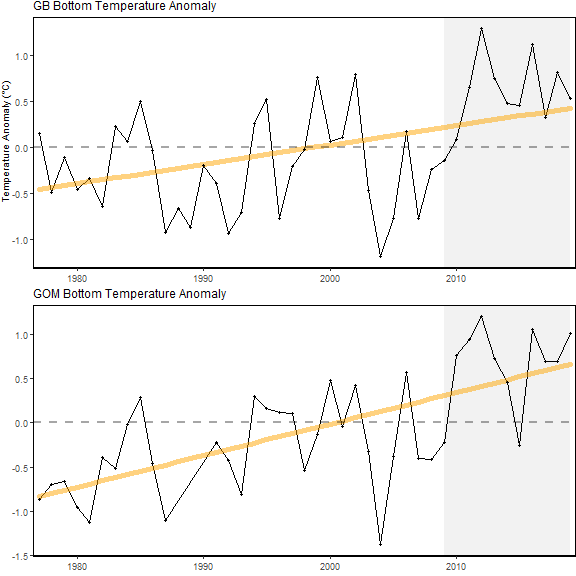 ] --- ## Marine heatwaves: Georges Bank (New) .pull-left[ * Three distinct marine heatwaves * Strongest: Aug 17 - Sept 5 (20 days) * 15th maximum intensity (+3.14 °C above average on Aug 23) * Strongest heatwaves * Maximum intensity - 2016 (+4.06 °C above average) * Cumulative intensity - 2012 (485 °C-days) ] .pull-right[ 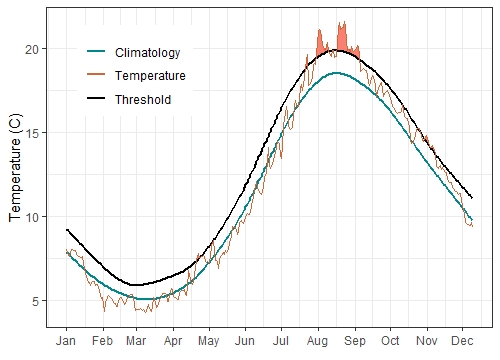 ] .center[  ] --- ## Marine heatwaves: Georges Bank (New) .center[ 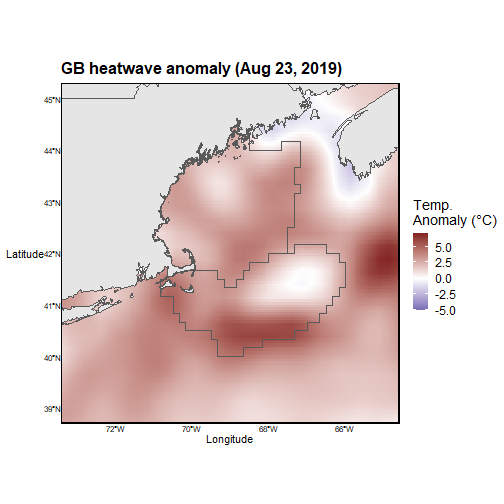 ] --- ## Marine heatwaves: Gulf of Maine (New) .pull-left[ * Four distinct marine heatwaves * Strongest: July 3 - Aug 24 (53 days) * 12th maximum intensity (+3.27 °C above average on Aug 1) * 12th cumulative intensity (112 °C-days) * Strongest heatwaves * Maximum intensity - 2010 (+4.83 °C above average) * Cumulative intensity - 2012 (630 °C-days) ] .pull-right[ 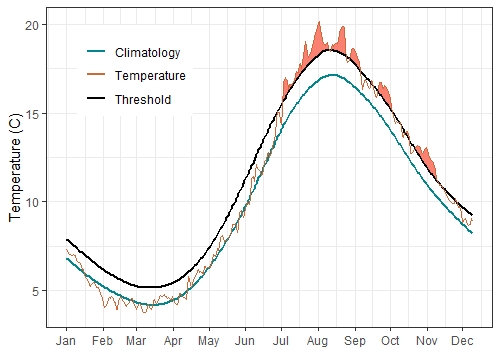 ] .center[  ] --- ## Marine heatwaves: Gulf of Maine (New) .center[ 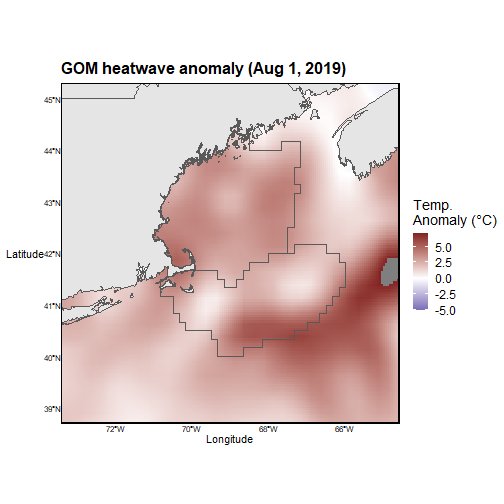 ] --- ## Patterns in primary production * Above average primary production * Summer production (warmer, nutrient recycling) * likely smaller-celled species * Spring bloom below average both regions .pull-left[ 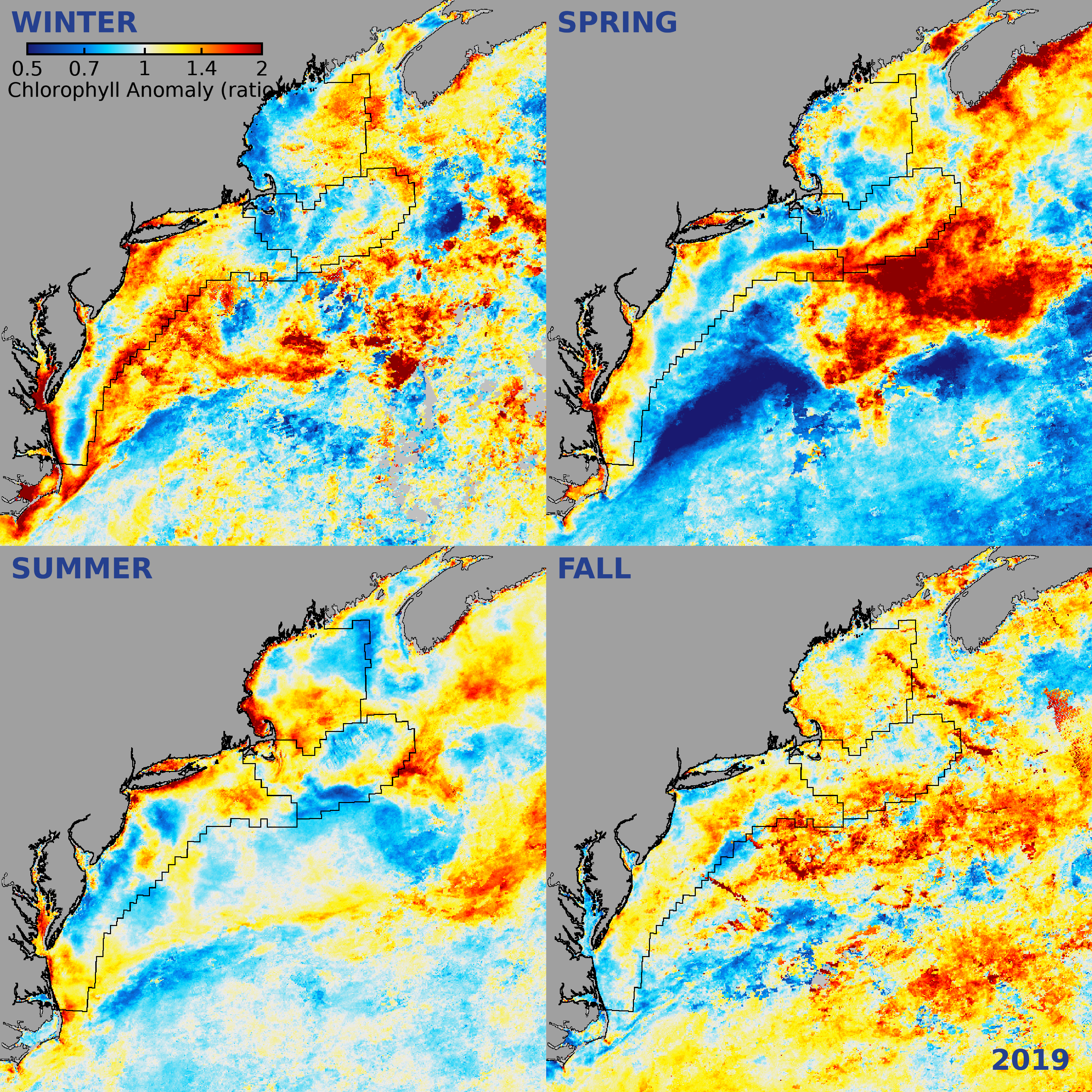 ] .pull-right[ 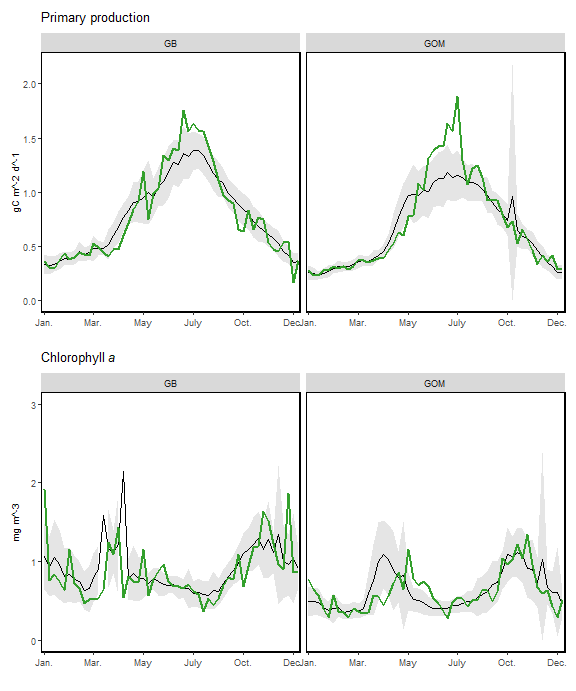 ] --- ## Patterns in Zooplankton * Large-bodied are mostly *Calanus finmarchicus* (an important prey for larval fish and the north Atlantic right whale) * Low abundance in GOM 2010-2014, GB 2010-2017 * Abundance of small-bodied *Temora longicornis* and *Centropages typicus* highest value observed in 2018 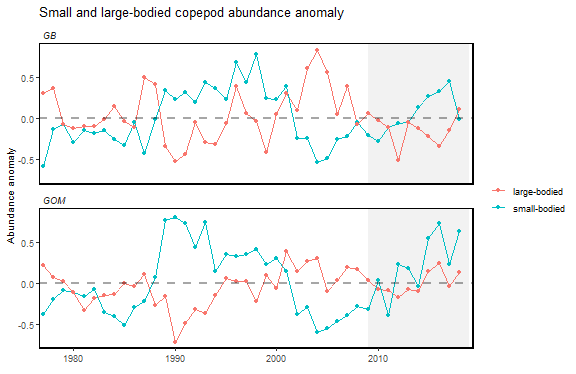 --- ## SOE Take Home Messages .center[ 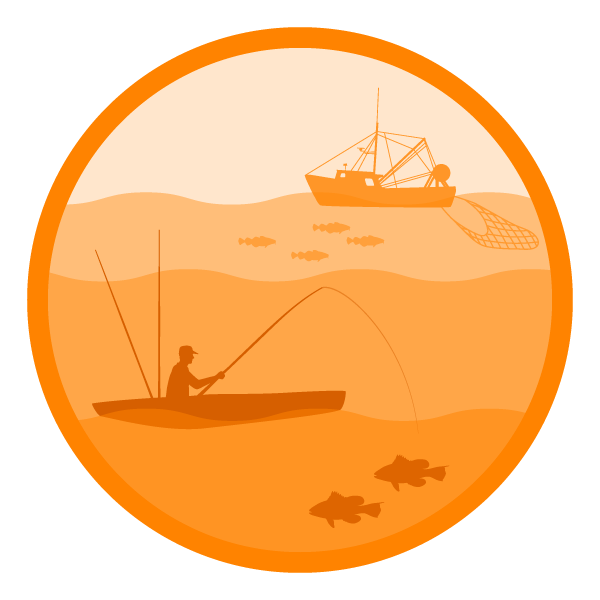 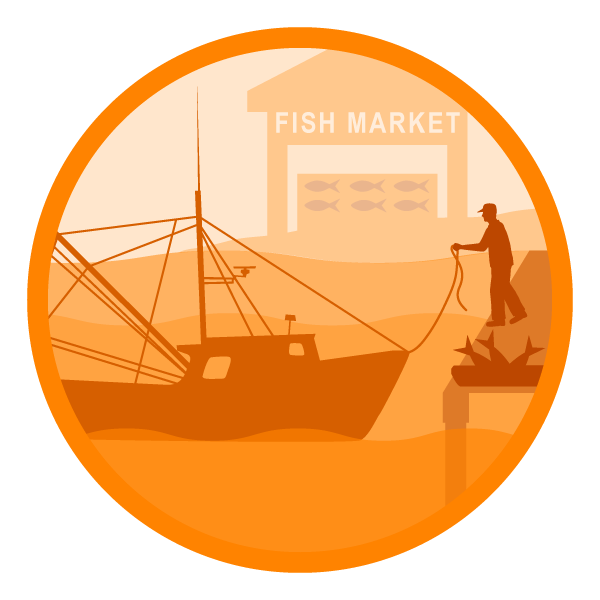 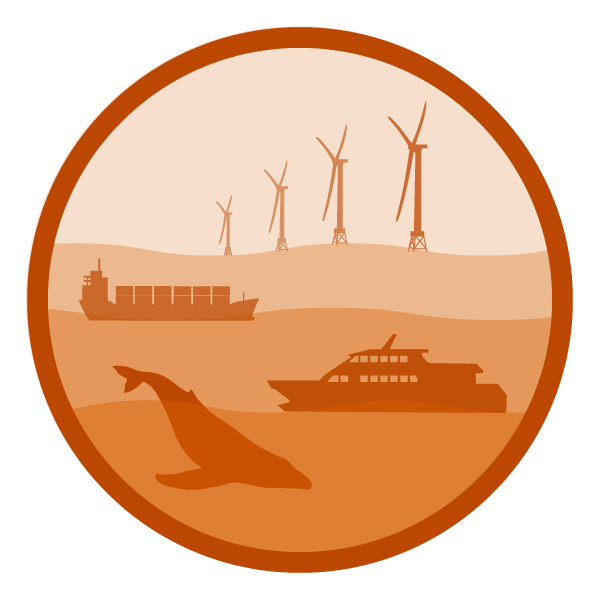 ] * Proportion of total primary production required to support commercial landings declining -- * Moderately engaged communities have increased since 2004 -- * New England commercial fisheries remain dependent on single species * Gulf of Maine - lobster * Georges Bank - scallops -- * 2018 commercial catch and revenue increased in both New England ecosystems * 2019 lobster catch is down substantially -- * Habitat modeling indicates several species that are highly likely to occupt wind energy lease areas * Habitat conditions have become more favorable over time for most --- ## SOE Take Home Messages .center[ 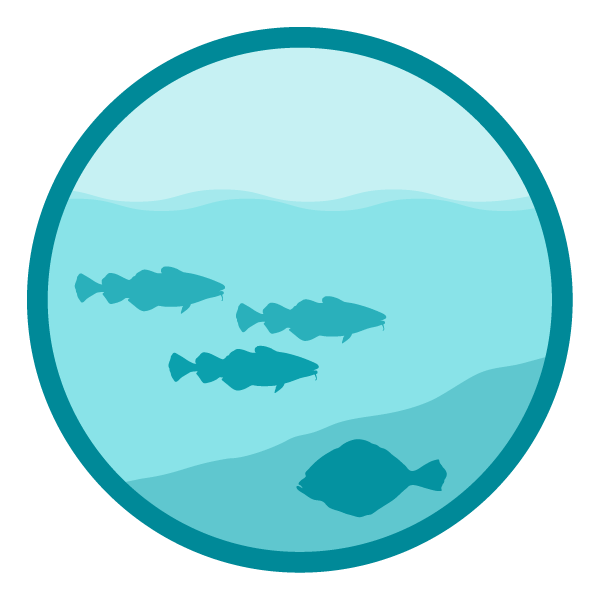 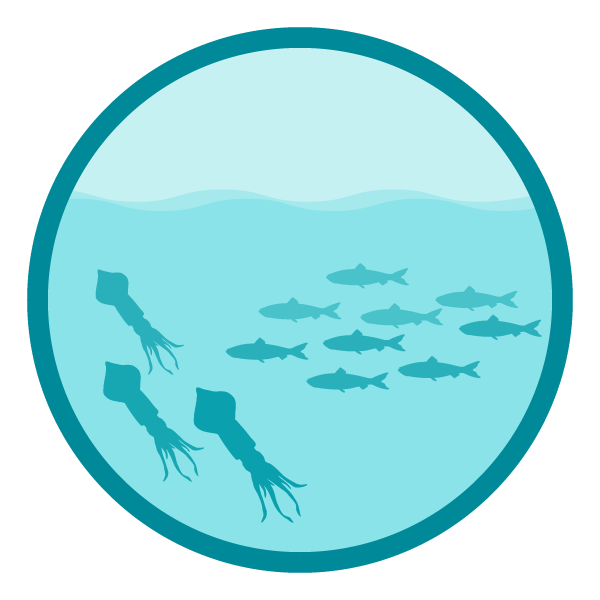 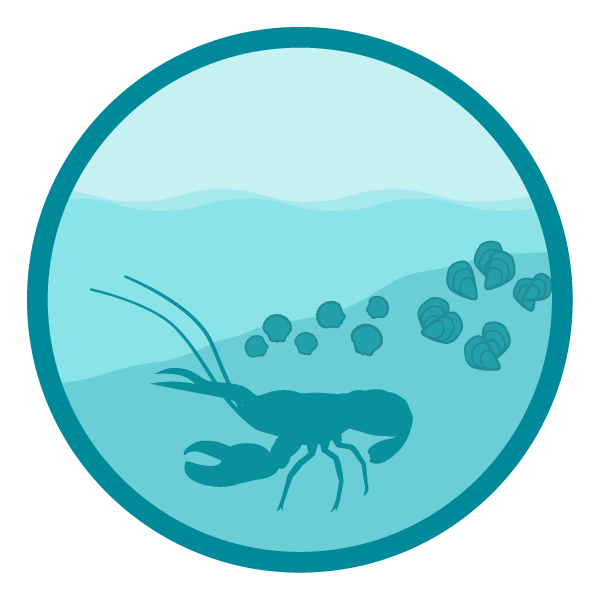 ] * Few apparent trends in aggregate biomass of predators, forage fish, bottom feeders, and shellfish sampled by trawl surveys * Haddock biomass is high -- * Continued northward shift in aggregate fish distribution and a tendency towards deeper waters -- * Forage fish energy content shows seasonal and annual variation * Atlantic herring energy content half what it was in the 1980-90s --- ## SOE Take Home Messages .center[ 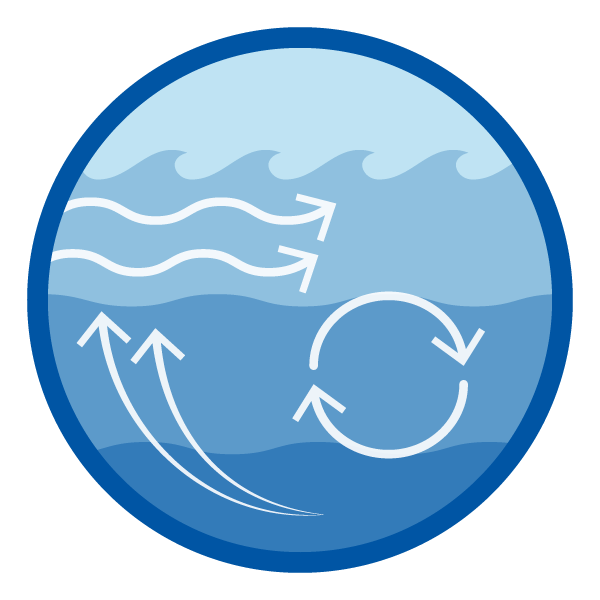 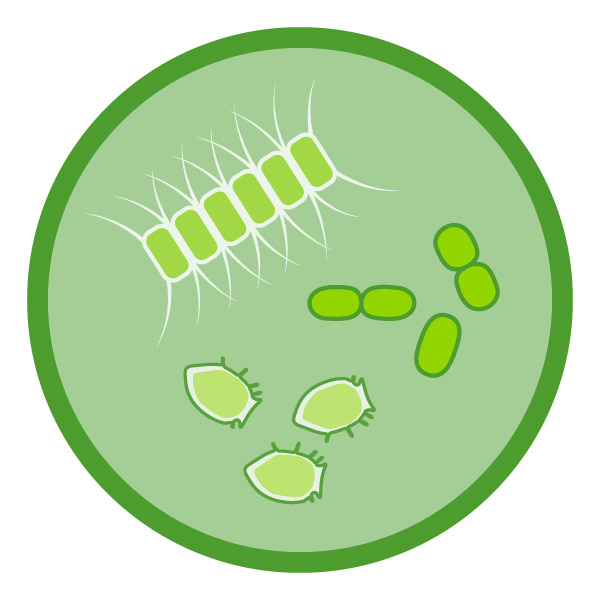 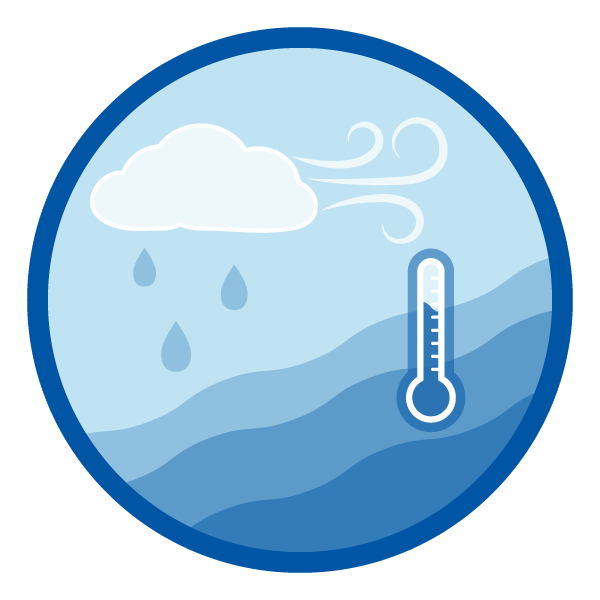 ] * Gulf Stream increasingly unstable * More warm core rings -- * Almost no cold Labrador slope water has entered the Gulf of Maine for the past 3 years -- * Gulf of Maine * Bottom and surface temperatures are high * Marine heat waves more common since 2010 * Small bodied zooplankton more abundant than large fatty zooplankton * Spring blooms have been below average since 2013 -- * Georges Bank * Also warming with increased marine heat waves * A number of warm core rings surrounded Georges Bank in the summer * Also dominated by small-bodied zooplankton --- ## External Resources * [SOE Technical Documentation](https://noaa-edab.github.io/tech-doc) * [ecodata R package](https://github.com/noaa-edab/ecodata) * [Macrofauna indicators](http://noaa-edab.github.io/ecodata/macrofauna) * [Human Dimensions indicators](http://noaa-edab.github.io/ecodata/human_dimensions) * [Lower trophic level indicators](http://noaa-edab.github.io/ecodata/LTL) * [ERDDAP server](https://comet.nefsc.noaa.gov/erddap/index.html) * [NOAA SOE summary webpage](https://www.fisheries.noaa.gov/new-england-mid-atlantic/ecosystems/state-ecosystem-reports-northeast-us-shelf) * Slides available at https://noaa-edab.github.io/presentations/ Contacts: <sarah.gaichas@noaa.gov>, <sean.lucey@noaa.gov>, <scott.large@noaa.gov> --- ## Contributors - THANK YOU! The New England and Mid-Atlantic SOEs made possible by (at least) 38 contributors from 8 intstitutions .pull-left[ .contrib[ Donald Anderson (Woods Hole Oceanographic Institute) <br> Andy Beet<br> Patricia Clay<br> Lisa Colburn<br> Geret DePiper<br> Michael Fogarty<br> Paula Fratantoni <br> Kevin Friedland<br> Sarah Gaichas<br> Avijit Gangopadhyay (School for Marine Science and Technology, University of Massachusetts Dartmouth)<br> James Gartland (Virginia Institute of Marine Science)<br> Glen Gawarkiewicz (Woods Hole Oceanographic Institution)<br> Sean Hardison<br> Kimberly Hyde<br> Terry Joyce (Woods Hole Oceanographic Institute)<br> John Kocik<br> Steve Kress (National Audubon Society)<br> Scott Large ] ] .pull-right[ .contrib[ Don Lyons (National Audubon Society)<br> Ruth Boettcher (Virginia Department of Game and Inland Fisheries)<br> Young-Oh Kwon (Woods Hole Oceanographic Institution)<br> Zhuomin Chen (Woods Hole Oceanographic Institution)<br> Sean Lucey<br> Chris Melrose<br> Ryan Morse<br> Kimberly Murray<br> Chris Orphanides<br> Richard Pace<br> Charles Perretti<br> Vincent Saba<br> Laurel Smith<br> Mark Terceiro<br> John Walden<br> Harvey Walsh<br> Mark Wuenschel ] ] .center[ 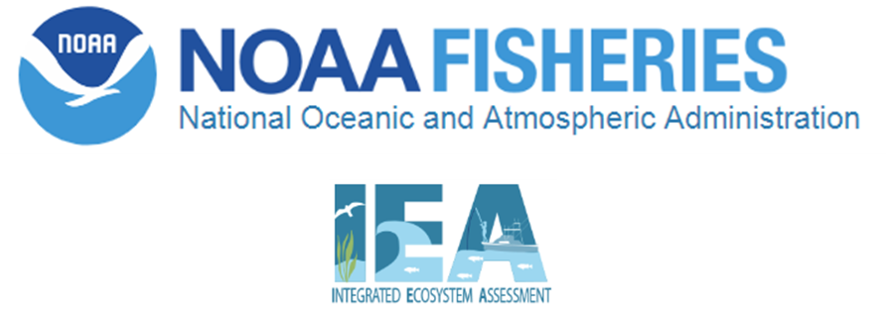 ] --- background-image: url("EDAB_images/SOE_feature_image.png") background-size: contain .footnote[Questions? Thank you!]